Articles
- Page Path
- HOME > J Korean Acad Nurs > Volume 46(6); 2016 > Article
-
Original Article
- Inhalation Effects of Aroma Essential Oil on Quality of Sleep for Shift Nurses after Night Work
- WonJong Kim, Myung-Haeng Hur
-
Journal of Korean Academy of Nursing 2016;46(6):769-779.
DOI: https://doi.org/10.4040/jkan.2016.46.6.769
Published online: December 30, 2016
1Department of Nursing, Gimcheon University, Gimcheon, Korea.
2College of Nursing, Eulji University, Daejeon, Korea.
- Address reprint requests to : Hur, Myung-Haeng. College of Nursing, Eulji University, 77 Gyeryong-ro 771 beon-gil, Jung-gu, Daejeon 34824, Korea. Tel: +82-42-259-1714, Fax: +82-42-259-1709, mhhur@eulji.ac.kr
© 2016 Korean Society of Nursing Science
This is an Open Access article distributed under the terms of the Creative Commons Attribution NoDerivs License. (http://creativecommons.org/licenses/by-nd/4.0/) If the original work is properly cited and retained without any modification or reproduction, it can be used and re-distributed in any format and medium.
Abstract
-
Purpose
- This study was an experimental study to compare the inhalation effects of aroma essential oil on the quality of sleep (QOS) for shift nurses after working nights.
-
Methods
- The participants were 60 healthy adults who didn't have any disease. As an experimental treatment, the participants in the experimental group were asked to inhale essential oil for 3 minutes at a distance of approximately 10 cm fromt heir nose and then they were asked to sleep with the aroma stone beside their head (within a 30 cm distance). QOS were measured four times on Pretest, Day 1, Day 2, and Day 3 after they slept. To measure QOS, Perceived QOS (Numeric Rating Scale), the Verran & Synder-Halpern (VSH) Sleep Scale were used, and number of awakenings (NoA) was measured by Actigraph.
-
Results
- There were no significant differences in the homogeneity tests for general characteristics and dependent variables prior to the experiments, except for VSH of subjective sleep quality. Also, there was no significant interaction between group and time. The VSH of the experimental group was higher than the control group (F=6.39, p=.002). The NoA between the experimental group and the control group was significantly different after experimental treatment 3rd day (F=13.35, p=.001).
-
Conclusion
- The findings show that the inhalation of aroma essential oil had effects to increase the quality of sleep. Therefore, the inhalation of aroma essential oil could be applied to general nursing interventions to improve the quality of sleep.
This manuscript is based on a part of the first author's master's thesis from Eulji University.
This research was supported by Basic Science Research Program through the National Research Foundation of Korea (NRF) funded by the Ministry of Science, ICT & Future Planning (NRF-2015R1A1A3A04001441).
- 1. Im SB, Yu SY, Seo EB, Lee SJ, Yun BR, Seo EJ, et al. The effects of shift work on the nurses’ negative affectivity and sleep disorder. J Korean Acad Psychiatr Ment Health Nurs. 2006;15(1):40–47.ArticlePDF
- 2. Lee KJ, Kim MR, Lee AS, Lee JH, Chang YH, Chung MS. Development of duty form for improvement of nurses working conditions. Seoul: Hospital Nurses Association; 2006.
- 3. Son YJ, Park YR. Relationships between sleep quality, fatigue and depression on health promoting behavior by shift-work patterns in university hospital nurses. J Korean Biol Nurs Sci. 2011;13(3):229–237.
- 4. Akerstedt T, Wright KP Jr. Sleep loss and fatigue in shift work and shift work disorder. Sleep Med Clin. 2009;4(2):257–271. ArticlePubMedPMC
- 5. Shin MR. The relationship between the change in number of endothelial progenitor cells and the lack of sleep in medical students [master's thesis]. Seoul, Korea University. 2013;1–14.
- 6. Trendall J. Concept analysis: Chronic fatigue. J Adv Nurs. 2000;32(5):1126–1131. ArticlePubMed
- 7. Lee HY, Kim SY. The trends of nursing research on aromatherapy in Korea. J East West Nurs Res. 2010;16(2):85–95.
- 8. Nasel C, Nasel B, Samec P, Schindler E, Buchbauer G. Functional imaging of effects of fragrances on the human brain after prolonged inhalation. Chem Senses. 1994;19(4):359–364. ArticlePubMed
- 9. Cho SJ. The miracle of aromatherapy. Seoul: SKbooks; 2006. p. 1–236.
- 10. Oh HK. Aromatherapy handbook. Seoul: Yangmoon; 2002. p. 1–191.
- 11. Oh HK. Naturopathic medicine. Seoul: Garambooks; 1996. p. 1–474.
- 12. Choi JY, Oh HK, Chun KK, Lee JS, Park DK, Choi SD, et al. A study for antistress effects of two aromatic synergic blending oils. J Korean Soc Clin Neurophysiol. 2000;2(2):70–80.
- 13. Chang SB, Chu SH, Kim YI, Yun SH. The effects of aroma inhalation on sleep and fatigue in night shift nurses. J Korean Acad Adult Nurs. 2008;20(6):941–949.
- 14. Kim SJ, Gu MO. A study on the relationship among circadian types, sleep quality and adaptation to night shifts among nurses working on two or three day night duties. J Korean Clin Nurs Res. 2013;19(3):309–320.
- 15. Lee HS, Hwang HS, Kim YA. Effects of hand massage with aroma oil on stress responses and serum immunity of registered nurse during the night duty. J Korean Acad Soc Nurs Educ. 2007;13(2):169–176.
- 16. Buckle J. The role of aromatherapy in nursing care. Nurs Clin North Am. 2001;36(1):57–72.ArticlePubMed
- 17. Battaglia S. The complete guide to aromatherapy. Queensland, AU: International Centre of Holistic Aromatherapy; 2003. p. 1–602.
- 18. Pilcher JJ, Ginter DR, Sadowsky B. Sleep quality versus sleep quantity: Relationships between sleep and measures of health, well-being and sleepiness in college students. J Psychosom Res. 1997;42(6):583–596. ArticlePubMed
- 19. Kim KS. The effect of preparatory audiovisual information with videotape influencing on sleep and anxiety of abdominal surgical patients. J Korean Acad Fundam Nurs. 1994;1(1):19–36.
- 20. Lee EO, Lim NY, Park HA, Lee IS, Kim JI, Bae J, et al. Nursing research and statistics. Paju: Soomoonsa; 2009. p. 1–789.
- 21. Lichstein KL, Stone KC, Donaldson J, Nau SD, Soeffing JP, Murray D. Actigraphy validation with insomnia. Sleep. 2006;29(2):232–239.PubMed
- 22. Bae JM, Park GH. An illustrated guide to medical statistics using SPSS. Seoul: Hannarae Publishing Co.; 2012. p. 1–367. .
- 23. Kim L. Jet lag and circadian rhythms. Sleep Med Psychophysiol. 1997;4(1):57–65.
- 24. Cho MY, Min ES, Hur MH, Lee MS. Effects of aromatherapy on the anxiety, vital signs, and sleep quality of percutaneous coronary intervention patients in intensive care units. Evid Based Complement Alternat Med. 2013;2013:381381ArticlePubMedPMCPDF
- 25. Ju MS, Lee S, Bae I, Hur MH, Seong K, Lee MS. Effects of aroma massage on home blood pressure, ambulatory blood pressure, and sleep quality in middle-aged women with hypertension. Evid Based Complement Alternat Med. 2013;2013:403251. http://dx.doi.org/10.1155/2013/403251ArticlePubMedPMCPDF
- 26. Chien LW, Cheng SL, Liu CF. The effect of lavender aromatherapy on autonomic nervous system in midlife women with insomnia. Evid Based Complement Alternat Med. 2012;2012:740813ArticlePubMedPMCPDF
- 27. Ko YJ. Effects of lavender fragrance inhalation method on sleep, depression and stress of institutionalized elderly. J East West Nurs Res. 2012;18(2):74–80.
- 28. Seo SY, Chang SY. Effects of aroma hand massage on sleep, depression and quality of life in the institutionalized elderly women. Korean J Women Health Nurs. 2009;15(4):372–380. Article
- 29. Lillehei AS, Halcón LL, Savik K, Reis R. Effect of inhaled lavender and sleep hygiene on self-reported sleep issues: A randomized controlled trial. J Altern Complement Med. 2015;21(7):430–438. ArticlePubMedPMC
- 30. Fismer KL, Pilkington K. Lavender and sleep: A systematic review of the evidence. Eur J Integr Med. 2012;4(4):e436–e447. Article
REFERENCES
Comparison of QOS (NRS), QOS (VSH) and NoA between Two Groups (N=60)
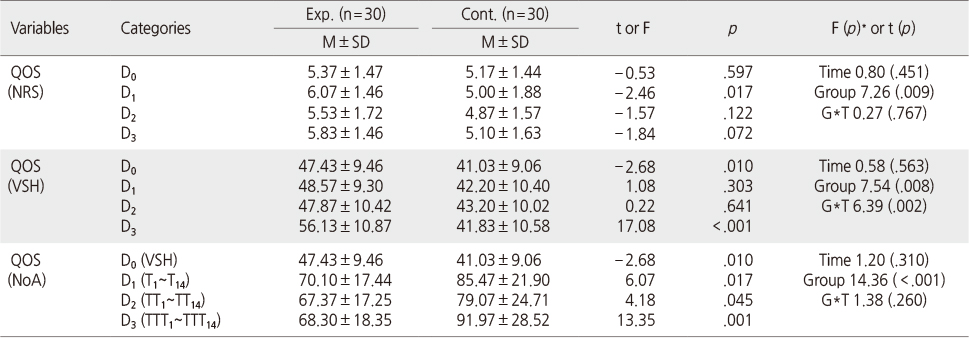
Exp. G=Experimental group; Cont. G=Control group; D0=Pretest day; D1=Post-test 1st day; D2=Post-test 2nd day; D3=Post-test 3rd day; QOS=Quality of Sleep; NRS=Numeric Rating Scale; VSH=Verran & Synder-Halpern sleep scale; NoA=Numbers of Awakenings; F (p)*=Repeated measures of ANCOVA (Covariates: NRS D0=5.27, VSH D0=44.2); G*t=Group*Time; T1~T14=30 min interval for 7 hours (1st day); TT1~TT14=30 min interval for 7 hours (2nd day); TTT1~TTT14=30 min interval for 7 hours (3rd day).
Figure & Data
REFERENCES
Citations

- The effects of aroma inhalation on the quality of sleep, professional quality of life, and near-misses in medication errors among emergency room nurses on night duty in Korea: a randomized controlled trial
Jungha Son, Chul-Gyu Kim
Journal of Korean Biological Nursing Science.2025; 27(1): 25. CrossRef - Effective Interventions for Reducing the Negative Effects of Night Shifts on Doctors’ and Nurses’ Health and Well-Being: A Systematic Review
Michael Shakhloul, Ahmed Amer, Mina Zekry, Mohamed Elgewely, Abanoub Saleeb, Shenoda Ghobrial, Mario Zaghar A Shehata, Ibrahim Abouelkhir, Muhammad O Kamal, Bishoy Manqaryos, Mahmoud Abdulfattah, Ahmed Syed, David Shakhloul, Mina Kamel
Cureus.2025;[Epub] CrossRef - The effect of Aromatherapy with Pelargonium graveolens (P. graveolens) on the fatigue and sleep quality of critical care nurses during the Covid-19 pandemic: A randomized controlled trial
Nasrin Karimi, Shirin Hasanvand, Afsaneh Beiranvand, Mohammad Gholami, Mehdi Birjandi
EXPLORE.2024; 20(1): 82. CrossRef - Meta-analysis of the Effect Size of Lavender Essential Oil and Lavender Blended Essential Oils on Psychological Factors in Adults
Mi-Na Yu, Ae-Jung Kim
Asian Journal of Beauty and Cosmetology.2024; 22(3): 477. CrossRef - Effectiveness of sleep interventions for rotating night shift workers: a systematic review and meta-analysis
Bo Min Jeon, Su Hyun Kim, Seung Hwa Shin
Frontiers in Public Health.2023;[Epub] CrossRef - Polymeric nanoparticles for enhanced delivery and improved bioactivity of essential oils
Sherif Babatunde Adeyemi, Aishat Mojisola Akere, Joshua Iseoluwa Orege, Onome Ejeromeghene, Odunola Blessing Orege, Jubril Olayinka Akolade
Heliyon.2023; 9(6): e16543. CrossRef - The Effects of Aroma Essential Oil Inhalation on Stress, Pain, and Sleep Quality in Laparoscopic Cholecystectomy Patients: A Randomized Controlled Trial
JiA Lee, Myung-Haeng Hur
Asian Nursing Research.2022; 16(1): 1. CrossRef - Effectiveness of aromatherapy inhalation on anxiety and haemodynamic variables for patients with cardiovascular disease: A systematic review and meta‐analysis
Selma Turan Kavradim, Şefika Tuğba Yangöz, Zeynep Ozer
International Journal of Clinical Practice.2021;[Epub] CrossRef - Effects of aromatherapy with essential oil massage on the sleep quality of critical care nurses: A randomized controlled trial
Hsiu-Chin Hsu, Mei-Hsiang Lin, Hsiu-Fang Lee, Chiu-Yen Wu, Chih-Ting Chou, Shu-Fen Lin
Complementary Therapies in Clinical Practice.2021; 43: 101358. CrossRef - The effect of rosemary essential oil inhalation on sleepiness and alertness of shift-working nurses: A randomized, controlled field trial
Ahmad Nasiri, Masoomeh Mo'tamed Boroomand
Complementary Therapies in Clinical Practice.2021; 43: 101326. CrossRef - Sleep quality among shift-work nurses: A systematic review and meta-analysis
Jiwon Kang, Wonjung Noh, Youngjin Lee
Applied Nursing Research.2020; 52: 151227. CrossRef - Effects of Aromatherapy on Sleep Quality: A Systematic Review and Meta-Analysis
Mi-Eun Kim, Ji Hee Jun, Muyng-Haeng Hur
Journal of Korean Academy of Nursing.2019; 49(6): 655. CrossRef - Effect of aromatherapy on cancer complications: A systematic review
Mansoureh Ashghali Farahani, Roghaiyeh Afsargharehbagh, Fatemeh Marandi, Mojgan Moradi, Seyed-Mehdi Hashemi, Mahdieh Poodineh Moghadam, Abbas Balouchi
Complementary Therapies in Medicine.2019; 47: 102169. CrossRef - The Effects of Aromatherapy Massage on Sleep Quality of Nurses on Monthly Rotating Night Shifts
Ying-Ying Chang, Chao-Ling Lin, Li-Yin Chang, Vincenzo De Feo
Evidence-Based Complementary and Alternative Medicine.2017;[Epub] CrossRef - Essential Oils and Their Constituents: An Alternative Source for Novel Antidepressants
Damião De Sousa, Rayanne Silva, Epifanio Silva, Elaine Gavioli
Molecules.2017; 22(8): 1290. CrossRef
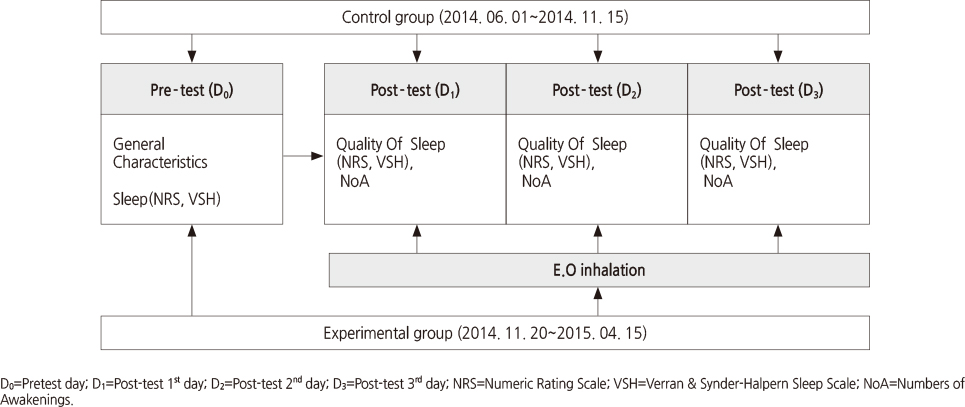
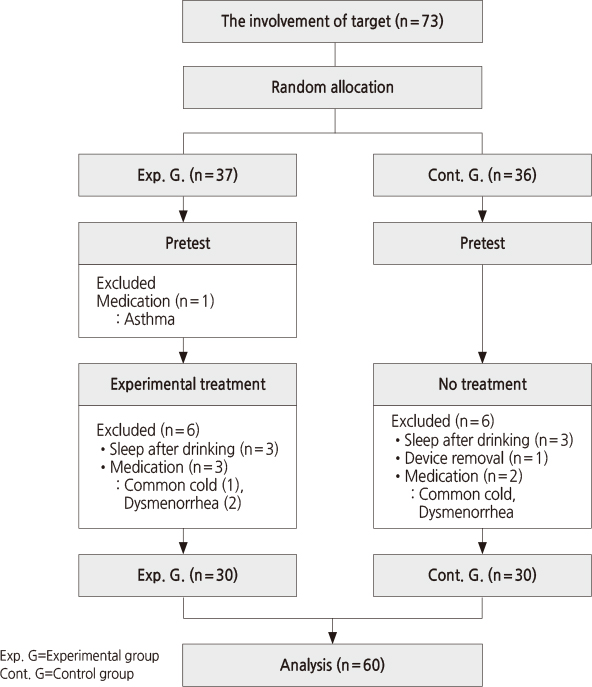
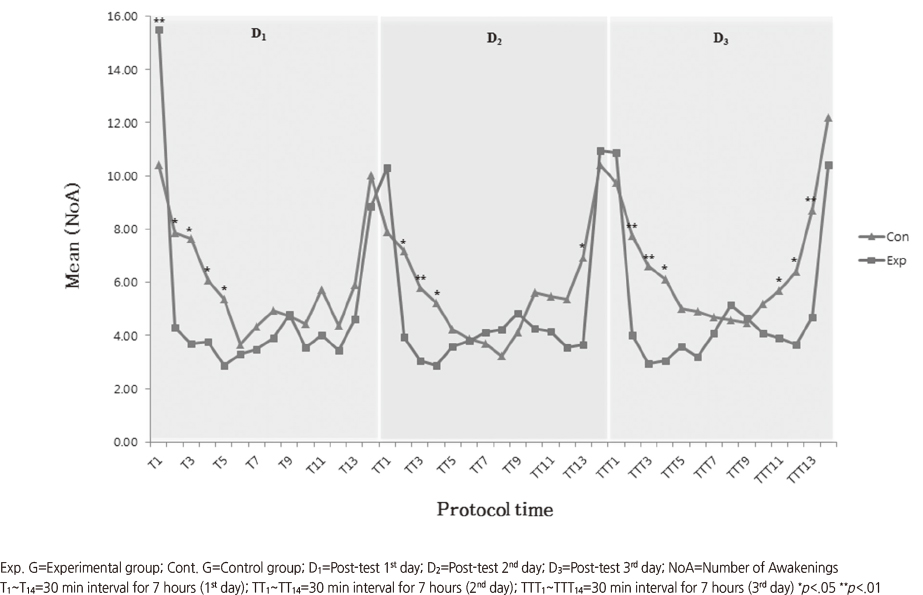
Figure 1
Figure 2
Figure 3
Homogeneity Tests of General Characteristics of the Participants (N=60)
*Fisher's exact test; Exp.=Experimental group; Cont.=Control group; St=Sleeping Time; QOS=Quality of Sleep: NRS=Numeric Rating Scale; VSH=Verran & Synder-Halpern sleep scale.
Comparison of QOS (NRS), QOS (VSH) and NoA between Two Groups (N=60)
Exp. G=Experimental group; Cont. G=Control group; D0=Pretest day; D1=Post-test 1st day; D2=Post-test 2nd day; D3=Post-test 3rd day; QOS=Quality of Sleep; NRS=Numeric Rating Scale; VSH=Verran & Synder-Halpern sleep scale; NoA=Numbers of Awakenings; F (p)*=Repeated measures of ANCOVA (Covariates: NRS D0=5.27, VSH D0=44.2); G*t=Group*Time; T1~T14=30 min interval for 7 hours (1st day); TT1~TT14=30 min interval for 7 hours (2nd day); TTT1~TTT14=30 min interval for 7 hours (3rd day).
*Fisher's exact test; Exp.=Experimental group; Cont.=Control group; St=Sleeping Time; QOS=Quality of Sleep: NRS=Numeric Rating Scale; VSH=Verran & Synder-Halpern sleep scale.
Exp. G=Experimental group; Cont. G=Control group; D0=Pretest day; D1=Post-test 1st day; D2=Post-test 2nd day; D3=Post-test 3rd day; QOS=Quality of Sleep; NRS=Numeric Rating Scale; VSH=Verran & Synder-Halpern sleep scale; NoA=Numbers of Awakenings; F (
 KSNS
KSNS
 E-SUBMISSION
E-SUBMISSION



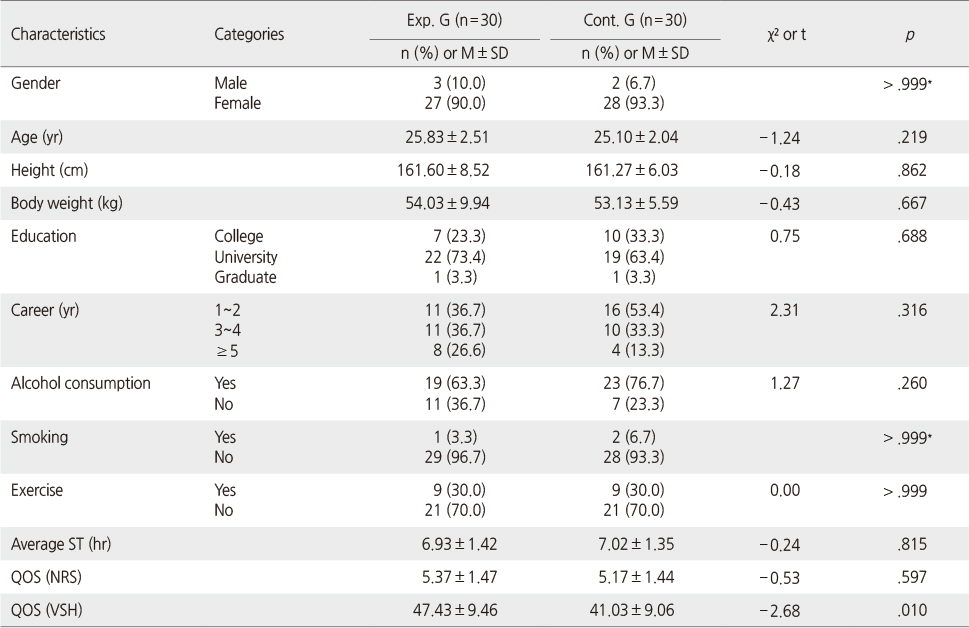
 Cite
Cite

